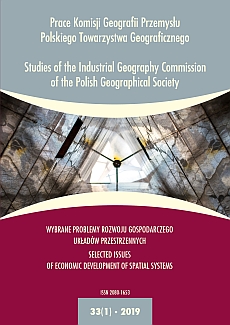Factors of Productivity Dynamics in Sections of Economic Activity in Poland
DOI:
https://doi.org/10.24917/20801653.331.5Keywords:
factors of production, Malmquist index, productivity changes, sections of economic activityAbstract
The aim of the study is to identify the types of economic activity in Poland that achieved the highest productivity dynamics, as well as to specify sources of the changes. It is empirically verified if the growth poles appear in a sphere of knowledge-based services. Decomposition of productivity changes into technological change and efficiency change is presented in the paper. Moreover, there are compared changes in total factor productivity, as well as changes in productivity of specified factors: labour, physical capital, and human capital and thus factoral sources of developmental dynamics are searched for. The presented research covers the period 2008-2016, that is specified by the appearance and breaking down the world economic crisis. To fulfil the research tasks the Malmquist index and its decomposition were used. The research results allow to confirm tendencies into a service knowledge-based economy’s development in Poland. As modern growth poles should be recognised the following sections: information and communication; financial and insurance activities; professional, scientific and technical activities. Specifying such sections as those with favourable productivity changes and technological progress creates some basis to direct structural policy to accelerate economic growth. Moreover, comparison of productivity dynamics of productive factors and its decomposition allows to conclude that a modern phase of changes in a structure of productive factors’ usage in Poland takes a form of extensive widening a range of knowledge use.Downloads
Metrics
References
Ahmed, E.M., Krishnasamy, G. (2013). Human Capital Investment to Achieve Knowledge-Based Economy in ASEAN5: DEA Applications. J Knowl Econ, 4, 331–342. DOI: 10.1007/s13132- 011-0059-2
Badunenko, O., Romero-Ávila, D. (2015). Productivity Growth across Industries and Regions: A Production-Frontier Approach Applied to the Spanish Case. Pozyskano z: http://www.alde.es/fotosbd/120620151100331636.pdf
Bassem, B.S. (2014). Total factor productivity change of MENA microfinance institutions: A Malmquist productivity index approach. Economic Modelling, 39, 182–189. DOI: 10.1016/j.econmod.2014.02.035
Chou, Y.-Ch., Shao, B.B.M. (2014). Total factor productivity growth in information technology services industries: A multi-theoretical perspective. Decision Support Systems, 62, 106–118. DOI: 10.1016/j.dss.2014.03.009
Clark, C. (1940). The Conditions of Economic Progress. London: Macmillan And Co. Limited.
Coelli, T. (1996). A Guide to DEAP Version 2.1: A Data Envelopment Analysis (Computer) Program. CEPA Working Paper, 96/08, 1–49.
Ćwiąkała-Małys, A., Nowak, W. (2011). Dekompozycja indeksu produktywności Malmquista w modeu DEA. Acta Universitatis Wratislaviensis, 3322, 273–284.
Diewert, W.E. (2015). Decompositions of productivity growth into sectoral effects. Journal of Productivity Analysis, 43, 367–387. DOI: 10.1007/s11123-014-0392-0
Eurostat (2018, 28 sierpnia). Baza danych statystycznych. National accounts employment data by industry (up to NACE A*64) [nama_10_a64_e]. National accounts aggregates by industry (up to NACE A*64) [nama_10_a64].
Employed HRST by category, age and NACE Rev. 2 activity (from 2008 onwards) [hrst_st_nsec2]. Pozyskano z https://ec.europa.eu/eurostat/ data/database
Färe, R., Grosskopf, S., Norris, M., Zhang, Z. (1994). Productivity Growth, Technical Progress, and Efficiency Change in Industrialized Countries. The American Economic Review, 84(1), 66–83.
Fisher, A.G.B. (1935). The Clash of Progress and Security. London: Macmillan.
Fura, B. (2017). Identyfikacja kluczowych sektorów polskiej gospodarki z wykorzystaniem analizy input-output. Studia i Prace Wydziału Nauk Ekonomicznych i Zarządzania Uniwersytetu Szczecińskiego, 47/2, 41–53. DOI: 10.18276/sip.2017.47/2-04
Gitto, S., Mancuso, P. (2015). The contribution of physical and human capital accumulation to Italian regional growth: a nonparametric perspective. Journal of Productivity Analysis, 43, 1–12. DOI: 10.1007/s11123-013-0362-y
Guzik, B. (2009). Podstawowe modele DEA w badaniu efektywności gospodarczej i społecznej.Poznań: Wydawnictwo Uniwersytetu Ekonomicznego w Poznaniu.
Kaasa, A. (2016). Social Capital, Institutional Quality and Productivity: Evidence from European Regions. Economics and Sociology, 9(4), 11–26. DOI: 10.14254/2071-789X.2016/9-4/1
Margaritis, D., Färe, R., Grosskopf, Sh. (2007). Productivity, convergence and policy: a study of OECD countries and industries. Journal of Productivity Analysis, 28, 87–105. DOI: 10.1007/ s11123-007-0044-
Murray, A. (2016). Partial versus Total Factor Productivity Measures: An Assessment of their Strengths and Weaknesses. International Productivity Monitor, 31, 113–126.
Silva, E.G., Teixeira, A.A.C. (2008). Surveying Structural Change: Seminal Contributions and a Bibliometric Account. Structural Change and Economic Dynamics, 19, 273–300. DOI: 10.1016/j.strueco.2008.02.001
Tanase, I., Tidor, A. (2012). Efficiency Progress and Productivity Change in Romania Machinery Industry 2001–2010. Procedia Economics and Finance, 3, 1055–1062. DOI: 10.1016/S2212- 5671(12)00273-0
Downloads
Published
How to Cite
Issue
Section
License
Articles are published under the terms of the Creative Commons License (CC BY-ND 4.0; Attribution– NoDerivs).

